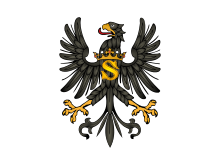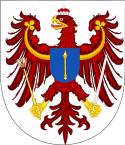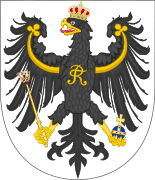Timeline of Kaliningrad
The following is a timeline of the history of the city of Kaliningrad, Russia. Prior to 1945, the city was known as Königsberg.

Emblem of Ducal Prussia
Era of Teutonic Order
  History of Brandenburg and Prussia | ||||
| Northern March 965–983 |
Old Prussians pre-13th century | |||
| Lutician federation 983 – 12th century | ||||
| Margraviate of Brandenburg 1157–1618 (1806) (HRE) (Bohemia 1373–1415) |
Teutonic Order 1224–1525 (Polish fief 1466–1525) | |||
| Duchy of Prussia 1525–1618 (1701) (Polish fief 1525–1657) |
Royal (Polish) Prussia (Poland) 1454/1466 – 1772 | |||
| Brandenburg-Prussia 1618–1701 | ||||
| Kingdom in Prussia 1701–1772 | ||||
| Kingdom of Prussia 1772–1918 | ||||
| Free State of Prussia (Germany) 1918–1947 |
Klaipėda Region (Lithuania) 1920–1939 / 1945–present |
Recovered Territories (Poland) 1918/1945–present | ||
| Brandenburg (Germany) 1947–1952 / 1990–present |
Kaliningrad Oblast (Russia) 1945–present | |||
Part of a series on the |
||||||||||||||||||||||||||
|---|---|---|---|---|---|---|---|---|---|---|---|---|---|---|---|---|---|---|---|---|---|---|---|---|---|---|
| History of Russia | ||||||||||||||||||||||||||
 | ||||||||||||||||||||||||||
|
||||||||||||||||||||||||||
| Timeline | ||||||||||||||||||||||||||
|
| ||||||||||||||||||||||||||
- 1255 – Fortress built by Teutonic Knights during Prussian Crusade.
- 1256 – Settlement formed north of the fortress.
- 1262 – Prussians begin to besiege castle during the Great Prussian Uprising.
- 1264 – Settlement developed south of the castle.
- 1286 – Königsberg chartered.[1]
- 1300 – Town of Löbenicht built.[2]
- 1324 – Town of Kneiphof founded.[2]
- 1340 – Königsberg joins Hanseatic League.[1]
- 1377 – Köttelbrücke (bridge) built.[3]
- 1379 (or 1397) – Schmiedebrücke (bridge) built.[4]
- 1380 – Cathedral built in Kneiphof (approximate date).
- 1387 – Kneiphof Town Hall renovated.
15th century
- 1457 – Königsberg becomes capital of the State of the Teutonic Order.[1]
- 1464 – Georg Steinhaupt becomes mayor.[3]
- 1466 - Second Treaty of Thorn
16th century
- 1519-21 - Polish-Teutonic War
- 1520 - Mikolaj Firlej lays siege to the town
- 1521-24 - Secularization of the Teutonic Order
- 1523 - Printing press in operation.[5]
- 1525 - Königsberg/Królewiec becomes the capital of the Duchy of Prussia, Albert becomes first Duke of Prussia[1]
- 1529 – Castle Library established
- 1542 - Pedagogium founded by Albert Hohenzollern in Kneiphof
- 1544 – Albertina University (Lutheran) founded.[2]
- 1560 - On 28 March 1560, King Zygmunt II August of Poland confers university privileges on the Albertina University, on a par with the Jagiellonian University.
- 1568 – March: Albert Frederick becomes Duke of Prussia.
- 1590 – Green Bridge rebuilt.
- 1594 – Schlosskirche (castle church) dedicated
17th century
- 1616 - A Catholic church erected by order of King Zygmunt III Vasa and the bishop of Warmia
- 1618 – Duchy of Prussia passes under control of Electors of Brandenburg, August: John Sigismund becomes Duke of Prussia
- 1619 – December: George William becomes Duke of Prussia
- 1626 – City walls built.[6]
- 1640 – December: Frederick William becomes Duke of Prussia
- 1647 – Neurossgarten Church dedicated
- 1657 -
- Brandenburg Gate built.
- Fort Friedrichsburg under construction[2]
- 1662 - the Brandenburg Elector enters city with an army and forces city fathers to swear an oath of allegiance[7]
- 1688 – April: Frederick becomes Duke of Prussia.
18th century
- 1701
- 18 January: Coronation of Frederick I of Prussia in the Schlosskirche.[6]
- Capital of Duchy of Prussia relocated from Königsberg to Berlin.
- 1709 – Plague.[6]
- 1718
- City Library opens.[8]
- Królewiec Post Polish-language newspaper begins publication (ceased in 1720).
- 1724
- 1735 – Math problem "Seven Bridges of Königsberg" presented.
- 1756 – Synagogue built.
- 1758
- 1764 – Russian occupation ends.[9]
- 1765 – Gumbinnen Gate built.
- 1780 – Theodor Gottlieb von Hippel becomes mayor.
- 1790 – Königshalle built.
19th century
- 1804 – 12 February: Immanuel Kant dies.
- 1807 – French in power.[6]
- 1809 – Paradeplatz city garden established.
- 1810 – August Wilhelm Heidemann becomes mayor.
- 1812 – School of church music founded.
- 1813 – Koenigsberg Observatory built.
- 1814 – Carl Friedrich Horn becomes mayor.
- 1826 – Johann Friedrich List becomes mayor.
- 1828 – Royal and University Library formed.[8]
- 1830 – Population: 54,000.[2]
- 1833 – University's Department of Chemistry opens in Neurossgarten.
- 1838 – Rudolf von Auerswald becomes mayor.
- 1845
- Union Giesserei foundry in business.
- New Altstadt Church dedicated.
- Art academy opens.[10]
- 1851 – Grolman Bastion built.
- 1855
- Sailing Club founded.
- Rossgarten Gate rebuilt.
- 1856 – Königsberg Cathedral restored.[1]
- 1858 – Dohna Tower built.
- 1860 – Astronomic Bastion built.
- 1861
- 18 October: Coronation of William I, German Emperor, in the Schlosskirche.
- Albertina University new campus dedicated.
- 1867 – Population: 101,507.[11]
- 1875
- Johann Karl Adolf Selke becomes mayor.
- Königsberg Stock Exchange built in Vorstadt.[12]
- 1878 – Königsberger Allgemeine Zeitung (newspaper) in publication.[13]
- 1880
- Bronsart Fort built.
- Population: 140,800.[1]
- 1883 – High Bridge rebuilt.
- 1886 – Siemering Museum established.[14]
- 1889 – Eisenbahnbrücke (bridge) opens.
- 1890 – Population: 161,666.[1]
- 1892 – Baltika Stadium opens.
- 1893 – Hermann Theodor Hoffmann becomes mayor.
- 1896 – Zoo founded.
- 1897 – Königsberger Tageblatt (newspaper) in publication.
- 1898 – Palaestra Albertina established.[15]
- 1900
- Football Club Königsberg formed.
- Population: 187,897.[9]
20th century
1900-1945
- 1901
- Queen Louise Memorial Church and Pillau-Königsberg canal built.[16][17]
- Königsberger Volkszeitung (newspaper) in publication.[18]
- 1903 – Siegfried Körte becomes mayor.
- 1906 – Bismarck tower built near city.
- 1907 – Church of the Holy Family built.
- 1912 – Stadthalle opens.
- 1913
- New Tragheim Church dedicated.
- Kunsthalle Königsberg (art gallery) opens.
- 1914 – City bombed by Russian forces.[19]
- 1919
- Hans Lohmeyer becomes mayor.
- City becomes part of the German Reich.
- Population: 260,895.[20]
- 1921 – Königsberg Devau Airport opens.
- 1927 – City Hall relocated to Hansaplatz.
- 1928 – Königsberg City Museum opens.
- 1929 – Central railway terminal opens.
- 1933 – Hellmuth Will becomes mayor.
- 1934 – Hansaplatz renamed Adolf-Hitler-Platz.
- 1939
- Lasch Bunker built in Paradeplatz.
- Population: 368,433.[19]
- 1941 – 1 September: Aerial bombing by Soviet forces begins.
- 1942 – 24 June: The Nazi SS sends the first deportation of Jews from Königsberg and East Prussia to extermination camps.[21]
- 1944 – August: Aerial bombing by British forces; city extensively damaged.
- 1945
- January: Battle of Königsberg begins.
- February: Metgethen massacre.
- 9 April: Battle of Königsberg ends; Soviets in power.[19]
1946-1990s
- 1946
- April: City becomes part of the Russian Soviet Federative Socialist Republic, per Potsdam Agreement.[22]
- City renamed Kaliningrad after Bolshevik Mikhail Kalinin.
- City becomes seat of the newly formed Kaliningrad Oblast.
- Kaliningrad Regional Museum of History and Arts founded.
- Kaliningradskaya Pravda newspaper begins publication.[13]
- 1947 – Kaliningrad Regional Drama Theatre established.
- 1954 – Pishchevik Kaliningrad football club formed.
- 1956 – Population: 188,000.
- 1960 – Theatre on Mira Avenue rebuilt.
- 1965 - Population: 253,000.[23]
- 1967 – Kaliningrad State University active.
- 1979
- Khrabrovo Airport terminal built.
- Kaliningrad Amber Museum opens.
- 1985 - Population: 385,000.[24]
- 1988 – Kaliningrad State Art Gallery established.[25]
- 1989 – Population: 401,280; oblast 871,283.
- 1990
- 1994 – Kaliningrad State Technical University active.
- 1996 – Leonid Gorbenko becomes governor of Kaliningrad Oblast.[29]
- 1998 – The Voice from the Pregel Polish-language magazine in publication.
21st century
- 2001 – Vladimir Yegorov becomes governor of Kaliningrad Oblast.
- 2005
- July: 750th anniversary of city founding.[30]
- Kaiser Bridge reconstructed (approximate date).
- Georgy Boos becomes governor of Kaliningrad Oblast.
- 2007
- Alexander Jaroschuk becomes mayor.[31]
- Khrabrovo Airport new terminal opens.[32]
- 2008 – Cathedral of Christ the Saviour consecrated.
- 2010
- 30 January: Protest against governor Georgy Boos.[33]
- Population: 431,500;[34] oblast 941,873.
- Nikolay Tsukanov becomes governor of Kaliningrad Oblast.
- 2012 – Poland-Russia border near Kaliningrad Oblast opens.[35]
See also
- History of Kaliningrad
- Königsberg
- List of monarchs of Prussia, 1525-1701
- Timelines of other cities in the Northwestern Federal District of Russia: Pskov, St. Petersburg
References
- "Königsberg", Encyclopædia Britannica (11th ed.), New York, 1910, OCLC 14782424
- David Brewster, ed. (1830). "Königsberg". Edinburgh Encyclopædia. Edinburgh: William Blackwood.
- Richard Armstedt (1899). Geschichte der königl. Haupt- und Residenzstadt Königsberg in Preussen [History of the Royal Capital and Residence City of Königsberg in Prussia] (in German). Stuttgart: Hobbing & Büchle.
- "Sites and projects". sg39.ru. Retrieved 2018-01-30.
- Henri Bouchot (1890). "Topographical index of the principal towns where early printing presses were established". In H. Grevel (ed.). The book: its printers, illustrators, and binders, from Gutenberg to the present time. London: H. Grevel & Co.
- George Henry Townsend (1867), "Königsberg (Prussia)", A Manual of Dates (2nd ed.), London: Frederick Warne & Co.
- Komunikaty Mazursko-Warmińskie, no 3–4, 1992, p. 254–255
- Julius Petzholdt (1853), Handbuch Deutscher Bibliotheken (in German), Halle: H.W. Schmidt, OCLC 8363581
- Benjamin Vincent (1910), "Konigsberg", Haydn's Dictionary of Dates (25th ed.), London: Ward, Lock & Co.
- Richard Armstedt (1895). Heimatkunde von Königsberg (in German). Königsberg: Koch.
- J. Niederstetter, ed. (1867). Staats-Almanach für das Königreich Preußen (in German). Berlin: Heymann.
- Norddeutscher Lloyd (1896), "Königsberg", Guide through Germany, Austria-Hungary, Italy, Switzerland, France, Belgium, Holland and England, Berlin: J. Reichmann & Cantor, OCLC 8395555
- "Kaliningrad Newspapers". WorldCat. USA: Online Computer Library Center. Retrieved 11 November 2013.
- Königliche Museen zu Berlin (1904). Kunsthandbuch für Deutschland (in German) (6th ed.). Georg Reimer.
- "Königsberg", Northern Germany (15th ed.), Leipzig: Karl Baedeker, 1910, OCLC 78390379
- Eugene van Cleef (1945). "East Baltic Ports and Boundaries: With Special Reference to Königsberg". Geographical Review. 35 (2): 257–272. doi:10.2307/211478. JSTOR 211478.
- United States Hydrographic Office (1917). Baltic Pilot. 1. Washington, D.C.: Government Printing Office.
- "Zeitungsinformationssystem ZEFYS" [Newspaper Information System] (in German). Berlin State Library. Retrieved 19 November 2016.
- Webster's Geographical Dictionary, Springfield, Massachusetts: G. & C. Merriam Co., 1960, p. 529, OL 5812502M
- "Germany: Principal Towns". Statesman's Year-Book. London: Macmillan and Co. 1921. hdl:2027/njp.32101072368440 – via Hathi Trust.
- "Memorial Plaque to the Victims of the First Deportation from Königsberg". Information Portal to European Sites of Remembrance. Berlin, Germany: Stiftung Denkmal für die ermordeten Juden Europas. Retrieved 2019-07-18.
- Russell H. Fifield (1948). "International Affairs: The Postwar World Map: New States and Boundary Changes". American Political Science Review. 42 (3): 533–541. doi:10.2307/1949917. JSTOR 1949917.
- "Population of capital cities and cities of 100,000 and more inhabitants". Demographic Yearbook 1965. New York: Statistical Office of the United Nations. 1966.
- United Nations Department of Economic and Social Affairs, Statistical Office (1987). "Population of capital cities and cities of 100,000 and more inhabitants". 1985 Demographic Yearbook. New York. pp. 247–289.
- "Russianmuseums.info". Russian Cultural Heritage Network. Retrieved 11 November 2013.
- Europa World Year Book 2004. Taylor & Francis. ISBN 1857432533.
- История Палаты [History of the Chamber] (in Russian). Калининградская торгово-промышленная палата (Kaliningrad Chamber of Commerce). Archived from the original on 12 April 2012. Retrieved 11 November 2013.
- G.J. Ashworth; J.E. Tunbridge (1999). "Old cities, new pasts: Heritage planning in selected cities of Central Europe". GeoJournal. 49 (1): 105–116. doi:10.1023/A:1007010205856. JSTOR 41147404.
- Patrick E. Tyler (5 April 2000). "In a Russian Region Apart, Corruption Is King". New York Times. Retrieved 11 November 2013.
- "Kaliningrad marks key anniversary". BBC News. 3 July 2005. Retrieved 11 November 2013.
- "Mayors in Europe". City Mayors.com. London: City Mayors Foundation. Retrieved 11 November 2013.
- "Kaliningrad profile". BBC News. Retrieved 11 November 2013.
- "Restlessness in Russia's Western Outpost". New York Times. 25 March 2010. Retrieved 11 November 2013.
- "Population of Capital Cities and Cities of 100,000 or More Inhabitants". Demographic Yearbook 2011. United Nations Statistics Division. 2012.
- "Crack in the EU: Poland and Kaliningrad Open Borders for Locals". Spiegel Online. 2 August 2012. Retrieved 11 November 2013.
This article incorporates information from the German Wikipedia and Russian Wikipedia.
Bibliography
in English
- Published in the 18th-19th century
- Thomas Nugent (1749), "Königsberg", The Grand Tour, 2: Germany and Holland, London: S. Birt, hdl:2027/mdp.39015030762572
- Richard Brookes (1786), "Konigsburg", The General Gazetteer (6th ed.), London: J.F.C. Rivington
- Jedidiah Morse; Richard C. Morse (1823), "Königsberg", A New Universal Gazetteer (4th ed.), New Haven: S. Converse
- Augustus Bozzi Granville (1829). "(Königsberg)". St. Petersburgh: A journal of travels to and from that capital. H. Colburn.
- "Königsberg", Leigh's New Descriptive Road Book of Germany, London: Leigh and Son, 1837
- "Königsberg". Penny Cyclopaedia. London. 1839.
- "Königsberg". Handbook for North Germany. London: J. Murray. 1877.
- John Ramsay McCulloch (1880), "Königsberg", in Hugh G. Reid (ed.), A Dictionary, Practical, Theoretical and Historical of Commerce and Commercial Navigation, London: Longmans, Green, and Co.
- W. Pembroke Fetridge (1884), "Königsberg", Harper's Hand-Book for Travellers in Europe and the East (23rd ed.), New York: Harper & Brothers, hdl:2027/nyp.33433066588363
- "Königsberg", Bradshaw's Illustrated Hand-book to Germany and Austria, London: W.J. Adams & Sons, 1896
- Published in the 20th century
- "Kaliningrad", Scandinavian & Baltic Europe (4th ed.), Lonely Planet, 1999, p. 300+, OL 8314793M
- James Charles Roy (1999). The Vanished Kingdom: Travels Through the History of Prussia. Basic Books. ISBN 978-0-8133-3793-7.
- Olga Sezneva (2000). "Historical Representation and the Politics of Memory in Kaliningrad, Former Königsberg". Polish Sociological Review (131): 323–338. JSTOR 41274763.
- Published in the 21st century
- Peter Savodnik (2003). "Kaliningrad". Wilson Quarterly. 27 (2): 16–22. JSTOR 40261179.
- Ann Kennard (2010). "Case Study 1: Kaliningrad". Old Cultures, New Institutions: Around the New Eastern Border of the European Union. LIT Verlag Münster. pp. 133–161. ISBN 978-3-643-10751-0.
in other languages
- Karl Faber (1840). Die Haupt- und Residenz-Stadt Königsberg in Preußen [Capital and Residence City of Königsberg in Prussia] (in German). Königsberg: Gräfe und Unzer.
- Alexander Jung (1846). Königsberg und die Königsberger (in German). Leipzig: Hermann Kirchner.
- F.W. Schubert (1855). Zur sechshundertjährigen Jubelfeier der Stadt Königsberg [600th Jubilee Celebration of the City of Königsberg] (in German). Königsberg: Verlag von Schubert und Seidel.
- "Konigsberg". Biblioteca geographica: Verzeichniss der seit der Mitte des vorigen Jahrhunderts bis zu Ende des Jahres 1856 in Deutschland (in German). Leipzig: Wilhelm Engelmann. 1858. (bibliography)
- August Wilhelm Grube (1875). "Königsberg". Charakterbilder Deutschen Landes und Lebens fur Schule und Haus (in German) (10th ed.). Leipzig: F. Brandstetter.
- "Königsberg". Brockhaus' Konversations-Lexikon (in German) (14th ed.). Leipzig: Brockhaus. 1898.
- P. Krauss; E. Uetrecht, eds. (1913). "Konigsberg". Meyers Deutscher Städteatlas [Meyer's Atlas of German Cities] (in German). Leipzig: Bibliographisches Institut.
- Institut für vergleichende Städtegeschichte, eds. (1979), "Konigsberg", Deutscher Städteatlas (in German), 2, ISBN 3891150008CS1 maint: uses editors parameter (link)
- Wolfgang Adam; Siegrid Westphal, eds. (2012). "Königsberg". Handbuch kultureller Zentren der Frühen Neuzeit: Städte und Residenzen im alten deutschen Sprachraum (in German). De Gruyter. pp. 1153+. ISBN 978-3-11-029555-9.
External links
| Wikimedia Commons has media related to Königsberg. |
| Wikimedia Commons has media related to Kaliningrad. |
- Europeana. Items related to Kaliningrad, various dates.
- Digital Public Library of America. Items related to Kaliningrad, various dates
- Links to fulltext city directories for Konigsberg via Wikisource
This article is issued from Wikipedia. The text is licensed under Creative Commons - Attribution - Sharealike. Additional terms may apply for the media files.